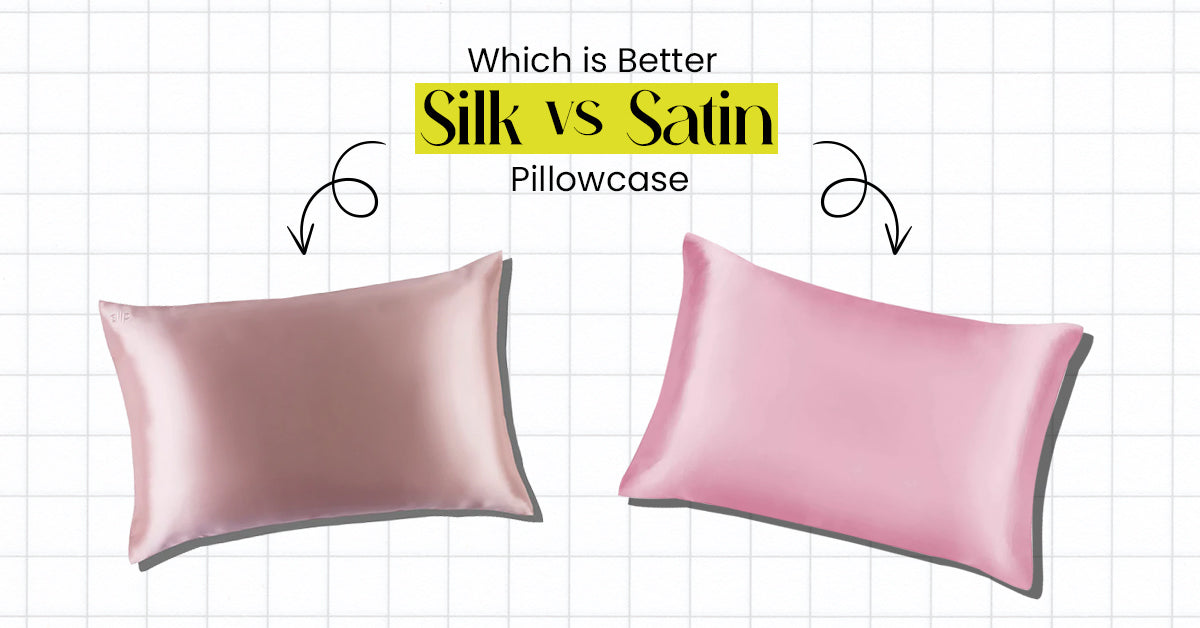In the realm of beauty sleep, pillowcases play a surprisingly significant role. While the primary function of a pillowcase is to provide a clean and comfortable surface for resting your head, the material of your pillowcase can affect the health of your skin and hair and the quality of your sleep. Two popular choices are silk and satin pillowcases, each with unique properties and benefits. But which one is truly better? In this blog, we'll delve deep into the key differences, benefits, and care tips for silk and satin pillowcases to help you make an informed decision.
Key Differences Between Silk and Satin
What Are the Differences in Material Composition?
Silk: Silk is a natural fibre produced by silkworms. It's made from protein and has a luxurious, smooth texture. The most common and sought-after type of silk is mulberry silk, renowned for its strength, softness, and lustre. Since silk is a natural fibre, it tends to be more expensive and requires more delicate care.

Satin: Satin, on the other hand, is a weave rather than a fibre. Satin can be made from various materials, including silk, polyester, and nylon. The weave creates a glossy surface with a dull back, giving satin its signature shine. It is generally more affordable than silk because satin can be made from synthetic fibres.

How to Do Silk and Satin Differ in Texture?
Silk: Silk pillowcases are incredibly smooth and soft to the touch. This smoothness reduces friction against the skin and hair, which can help prevent wrinkles and hair breakage. The natural fibres also allow for breathability, making silk pillowcases comfortable to sleep on year-round.
Satin: Satin pillowcases also have a smooth, shiny surface that feels luxurious against the skin. The texture is similar to silk but can vary slightly depending on the fibres used in the weave. Synthetic satin might not be as breathable as silk, but it still offers a soft, slick surface that reduces friction.
How Do They Differ in Appearance?
Silk: Silk pillowcases have a natural sheen that is elegant and understated. The lustre of silk is more subtle than satin, but it still adds a touch of luxury to your bedding.
Satin: Due to the weaving technique, satin pillowcases have a more pronounced shine. They look glossy and glamorous, often catching the light more than silk. This can make satin pillowcases appear more vibrant and eye-catching.
Benefits of Silk Pillowcases

Silk pillowcases are celebrated for their skin-friendly properties. The smooth surface of silk reduces friction, which can help prevent the formation of sleep lines and wrinkles. Silk is less absorbent than cotton, meaning it won't strip your skin of its natural oils or skincare products before bed. This can be especially beneficial for those with dry or sensitive skin.
1.How Does Silk Benefit Hair Health?
Silk pillowcases are equally beneficial for hair health. The smooth texture reduces friction and tugging, reducing hair breakage and split ends. This is particularly advantageous for those with curly or textured hair, as it helps maintain its natural shape and prevents frizz.
2.Is Silk Hypoallergenic?
Yes, silk is naturally hypoallergenic. It resists dust mites, mould, and other allergens, making it an excellent choice for people with allergies or sensitive skin. Silk's hypoallergenic properties can contribute to a cleaner and healthier sleeping environment.
3.How Does Silk Regulate Temperature?
Silk is a natural temperature regulator. It can wick away moisture and help maintain a comfortable body temperature, whether hot or cold, throughout the night. Thus, silk can provide a cosy and comfortable sleeping experience.
4.What is the Durability of Silk Pillowcases?
While silk is a delicate material, it can be quite durable with proper care. High-quality silk pillowcases, like those made from mulberry silk, are known for their strength and longevity. However, they require gentle handling and care to maintain their appearance and benefits over time.
Benefits of Satin Pillowcases

Satin pillowcases offer similar skin benefits to silk. The smooth surface helps reduce friction, preventing sleep lines and wrinkles. Satin also tends to be less absorbent than cotton, helping to keep your skin's moisture intact. This can be particularly beneficial for people with dry or sensitive skin.
1.How Does Satin Benefit Hair Health?
Satin pillowcases are also excellent for hair health. The slippery surface reduces friction, minimising hair breakage and split ends. Satin can also help maintain the shape of curly or textured hair, reducing frizz and keeping hairstyles looking fresh.
2.Is Satin Hypoallergenic?
Satin made from synthetic fibres like polyester can have hypoallergenic properties. It resists dust mites and other common allergens, making it a good choice for people with allergies. However, it's important to check the specific material composition, as some blends may vary.
3.How Does Satin Regulate Temperature?
Satin pillowcases, especially those made from synthetic fibres, may not regulate temperature as well as silk. However, they still provide a comfortable sleeping surface that can help keep you cool in warmer weather. Some high-quality satin pillowcases from natural fibres can offer better breathability and moisture-wicking properties.
4.What is the Durability of Satin Pillowcases?
Satin pillowcases made from synthetic fibres are generally more durable and easier to care for than silk. They can withstand regular washing and wear without losing their lustre or smoothness. However, the quality of satin pillowcases can vary, so choosing a reputable brand for the best results is essential.
Which Is Better, Silk Or Satin Pillowcase?
Deciding between silk and satin pillow cases ultimately depends on personal preference and priorities. Here are some factors to consider:
Budget: If you're looking for a more affordable option, satin pillowcases made from synthetic fibres can provide many of the same benefits as silk without the higher price tag.
Allergies: Silk and high-quality satin can be good for allergies or sensitive skin. However, silk is naturally hypoallergenic and might be the better option for those with severe allergies.
Hair and Skin Care: Both silk and satin pillowcases can help reduce friction and prevent damage to hair and skin. However, silk might be slightly more effective for curly or textured hair due to its natural properties.
Temperature Regulation: If temperature regulation is your priority, silk's natural ability to wick moisture and regulate temperature can provide a more comfortable sleeping experience.
Maintenance: Consider how much effort you will put into maintaining your pillowcases. Silk requires more delicate care, while satin, especially synthetic satin, is generally easier to care for.
What Are the Differences in Longevity Between Silk and Satin?
When it comes to longevity, the durability of silk and satin pillowcases can vary based on the quality of the material and how well they are cared for.
Silk: High-quality silk pillowcases, such as those made from mulberry silk, can be durable if properly maintained. However, silk is a delicate material that requires gentle care to prevent damage. With the right care, silk pillowcases can last for several years.
Satin: Satin pillowcases made from synthetic fibres are more durable and easier to care for than silk. They can withstand regular washing and use without losing their smoothness or sheen. High-quality satin pillowcases can also last for several years with proper care.
Conclusion
Choosing between silk and satin pillowcases depends on your specific needs and preferences. Both materials offer unique skin and hair health benefits, temperature regulation, and sleep quality. Silk pillowcases are luxurious, hypoallergenic, and excellent at temperature regulation, making them ideal for those who invest in high-quality bedding. Satin pillowcases, particularly those made from synthetic fibres, provide a more affordable yet still luxurious alternative that is easy to care for and maintain.
Ultimately, whether you choose silk or satin, investing in a high-quality pillowcase can significantly enhance your beauty sleep, providing tangible benefits for your skin, hair, and overall comfort.
FAQs
Are Silk Pillowcases Worth The Investment?
Yes, silk pillowcases are worth the investment if you value luxurious, hypoallergenic bedding that offers numerous benefits for skin and hair health. Their natural temperature-regulating properties and durability (with proper care) make them valuable to your sleep routine.
Can Satin Pillowcases Provide Similar Benefits To Silk?
Yes, satin pillow cases can provide similar benefits to silk, such as reduced friction on the skin and hair, which can help prevent wrinkles and hair breakage. Satin, made from synthetic fibres, is also hypoallergenic and easier to care for than silk.
Which Pillowcase Is Better For Curly Hair?
Both silk and satin pillowcases are excellent for curly hair, as they reduce friction and help maintain the hair's natural shape. Silk may have a slight edge due to its natural fibres and superior breathability, but high-quality satin can also be highly effective.
Is silk or satin better for hair Sleep?
Both materials are great for hair sleeping, but silk is often considered better due to its natural properties. Silk's smooth texture reduces friction and moisture loss, helping to prevent hair breakage and frizz. Satin is also beneficial, especially if you prefer a more affordable option.
Is Silk Or Satin Pillowcases Better For Acne?
Silk pillowcases may be better for acne-prone skin due to their hypoallergenic properties and ability to resist dust mites and mould. Silk's smooth surface can also help reduce irritation and keep skincare products on your skin rather than absorbing them from the fabric. Satin pillowcases can also be beneficial, but choosing a high-quality, hypoallergenic satin is crucial.


